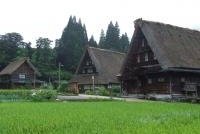
I too visited Ogimachi village in Shirakawa-go by taking the bus from Takayama. While Ogimachi was quite large and had many gassho houses, some of which I went inside to inspect, it was also very crowded and touristy.
From Ogimachi there are other buses that travel to Takaoka, and on the way stop at the other two villages, Ainokura and Suganuma in Gokayama, that form part of this WHS. They are equally authentic, but are much smaller and attract far fewer visitors than Ogimachi.
Keep reading 0 comments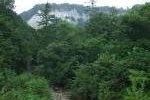
I found the most convenient way of seeing the Shirakami was from the train that runs along the narrow coastal strip from Fukaura south to Noshiro. From its windows I saw the passing panorama of the rocky coastline on one side and the seemingly impenetrable beech clad mountains on the other.
I travelled up and down this line several times, getting off a small stations. One station was called Juniko, and from here I took a bus that travelled inland to the Juniko Lakes area. From here walking tracks led into the Shirakami Sanchi National Park.
Keep reading 0 comments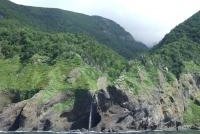
To view the Shiretoko Peninsular I took a cruise on the tourist ship 'Aurora' and sailed along the north coast of the peninsular. I boarded the vessel in the port of Utoro, which I reached by bus from outside Shiretoko Shari station.
The voyage provided a panoramic view of the bush clad peninsular, including its waterfalls, rock formations and steam rising from thermal vents along the ridge.
At Cape Shiretoko where a lonely lighthouse stands looking out towards the Russian Kurile Islands, clearly visible just a few kilometers away, the vessel turned to return to Utoro. This popular 4 hour cruise cost 6500 yen.
Keep reading 0 comments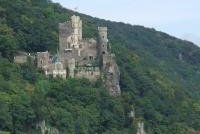
After having travelled the Rhine valley by train a couple of times I realised that I had missed a lot. So last year I took the KD boat from Bingen to Koblenz and saw both banks of the river from a moving vantage point in the middle. I didn't get off to visit any castles although it was possible. I would recommend this means of visiting this site.
Keep reading 0 comments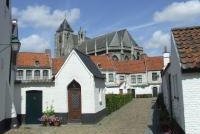
While seeking our belfries I also visited many of the Belgian beguinages:
Kortrijk - beguinage of St Elisabeth, a quiet and secluded courtyard
Ghent - Beguinage of the Virgin Mary, a large church
Ghent - St Amandsberg beguinage, secluded courtyard and gardens
Dendermonde - beguinage of St Alexius, large with a grassy courtyard
Bruges - large, peaceful, neat and tidy
Tongeren - untidy
Diest - pleasant garden with many statues
Leuven - large beguinage (small is not WHS), austere, serves as university staff accommodation
Mechlen - generally shabby, church is undergoing restoration
Turnhout - several grottoes and calvaries
Lier - untidy entrance, but neat garden beyond
Keep reading 0 comments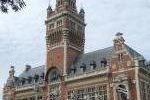
Visiting the belfries of northern France and Belgium involves travelling to many little-known towns that are well off the tourist trail. So on my visit to the region I covered some of the 56 included in the WHS, and found them to be all different - no two alike. It was quickly apparent that much of what I saw were copies, that the originals had been destroyed in WW1, WW11 or both:
Amiens - a short squat tower close to the cathedral (also a WHS)
Calais - a tall red brick tower attached to the town hall
Boulogne - square and grey, and now a war memorial
Hesdin - appears to poke out of the town hall roof, the lower part can be seen inside the tourist office
Rue - large squat tower
Abbeville - tall square tower
Loos - a tall red brick tower with corbels and turrets
Lille - very tall, slim red brick tower
Bethune - decrepit and grimy
Comines - red brick with onion dome roof
Gravellines - tall yellow brick tower
Dunkirk (St Eloi) - a tall square tower
Dunkirk (town hall) - red brick tower attached to the town hall
Bergues - tall yellow brick tower with onion dome roof
Bailleul - tall yellow brick tower with lantern roof
Armentiers - tall red brick tower with spire, attached to the town hall
Cambrai - tall grey stone, originally a church tower
Douai - grey stone tower attached to the town hall, with a brilliant …
Keep reading 0 comments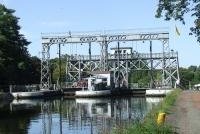
I spent some time on a fine summers day watching vessels pass along the canal and being raised or lowered through lifts 2 and 3, and certainly the procedure was ingenious. This was after following the tow path beside the canal from Braoquegnies Bridge, a few steps from Braoquegnies station (trains and buses to Mons).
Keep reading 0 commentsjohn booth
Routes of Santiago de Compostela in France
Routes of Santiago de Compostela in France (Inscribed)
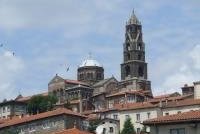
I don't have a problem with the French and Spanish routes being kept separate, I travelled them separately. But what bothers me is the amount of duplication; sites that are on the Route of St James of Compostela as well as being listed separately.
The sites that I have visited that are duplicated include:
Paris (Tour de St Jaques), Arles (Alyscamps), Vezelay church, Mont St Michel, Bordeaux (churches of St Seurin and St Michel, and St Andre cathedral), Bourges cathedral and Amiens cathedral.
The remaining sites that I have visited:
Toulouse - St Sernin basilica, an elegant structure, and Hotel Dieu (metro:St Cypriens)
Agen - St Caprais cathedral (white stone exterior and colouful interior)
Moissac - abbey and cloister (interior decor looked like wallpaper, but was hand painted in the 1960s).
St Lizier - St Peter's cathedral (bus from Boussens)
Auch - huge cathedral that dominates the skyline (train from Toulouse)
Figeac - Hospital St Jacques, still part of the town's hospital (a scenic bus route links Figeac and Cahors through the Lot valley).
Cahors - cathedral with stunning stained glass, and Valentre bridge.
Valcabrere - St Just church (train/bus to Laures-Barbazon)
Comminges - St Bertrand's cathedral with wood carvings and huge organ (walk from Valcabrere then climb 142 steps).
Gavarnie - parish church, being restored (a series of connecting buses from Lourdes)
Oloron Ste Marie - St Mary's cathedral, lots of stained glass and wood carvings (train from Pau)
Bayonne - cathedral with English and French royal coats of …
Keep reading 0 comments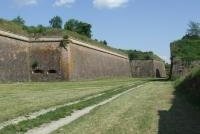
A word to describe Vauban's structures would be 'massive'. The defensive works all appear on a grand scale. But of the 12 locations forming this WHS, only the one at Longwy has been put to the test. The locations that I have visited are :
Neuf Brisach - huge fortifications, huge square and a huge red church (bus from Colmar)
Besancon - Fort Griffen (near the station) and Citadelle (free navette from Parking Chamars)
Briancon - steep streets within massive walls, with several entrance gates (train from Gap then bus #1 to Champ de Mars)
Mont Dauphin - steep hike from Mont Dauphin station (train from Gap)
Villefranche de Conflent - steep climb up to Fort Liberia through a tunnel in the cliff (train from Perpignan)
Mont Louis - fort with steep streets overlooking the Pyrenees (Petit Train Jaune to La Cabanasse)
Fort Medoc/Pate Island/Blaye - three forts on the Gironde river (train to Moulis-Listrac, bus to Cussak or Blaye, or ferry from Blaye to Lamarque)
Ile de Rey - sea walls and fortifications, citadelle occupied by the Militaire (bus from La Rochelle)
Camaret sur Mer - tower at the harbour entrance (bus from Quimper or Brest)
St Vaast La Hogue - fort on Tatihou Island and tower at La Hogue (bus from Cherbourg or Valognes, ferry to the island)
Longwy - massive fort forming the Upper Town, with ramparts, bastions and portals (train from Rheims or Luxembourg, navette to the Upper Town - except Sundays)
Arras - small fort …
Keep reading 0 comments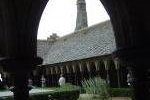
I stayed in the village of Pontorson and caught the bus to Mont St Michel from outside Pontorson station. It went right across the causeway and stopped at the entrance to the Mont. There are also direct buses from Rennes station that stop there.
Despite the huge number of visitors the abbey appeared well organised with no congestion as visitors follow a set route from the nave through several chapels, the cloisters and crypts and back onto the steps again.
Keep reading 0 comments
Travelled by bus from Poitiers bus station to St Savin sur Gartempe, arriving by the bridge over the river.
The abbey and the church with its tall spire dominate the village. The restoration work now having been completed the interior is magnificent again. The frescoes on the walls, columns and ceilings in the nave look bright and fresh, while those in the chancel are original and worn-looking. The ceiling frescoes, scenes from the Old Testament are especially interesting.
Keep reading 0 comments
Over the couse of three days I managed to visit 11 if the sites using a combination of trains and buses:
Chambord - (bus #18 from Blois) a huge but elegant structure set in spacious grounds. The frescoed ceilings were admirable as was the double circular staircase. But most interesting were the multitude of chimneys, turrets, dormers and other rooftop embellishments.
Cheverney - (bus #18 from Blois) smaller but equally elegant and a more colourful interior. Some nicely landscaped gardens too.
Blois - (train from Tours) interesting sculptures but not much else
Chinon - (train from Tours) more of a castle than a stately home. Took the lift from the town centre to the upper town and walked around the ramparts to reach the entrance. Great views of the Loire.
Azay Le Rideau - (train from Tours) a spartan interior but some interesting paintings and tapestries. Located on an island.
Saumur - (train from Tours, then bus #32 from the town centre up to the chateau) a castle built for defensive purposes.
Langeais - (train from Tours) a moat, drawbridge and keep, but very little else.
Orleans - a huge bronze statue of Joan of Arc
Chaumont - (train to Onzain, then walk across the bridge) an austere looking stately home.
Amboise - burial place of Leonardo da Vinci in the St Hubert chapel.
Tours - a small chateau by the river. Also interesting was the Museum of Compagnonnage (tradesmen and artisans) in St Julien's cloister
Keep reading 0 comments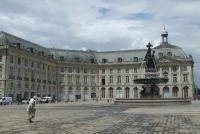
To get around the large city area I invested 4.10 euros in a day ticket for the trams and buses. During the course of the day I visited the three sites duplicated on the WHS Way of St James, the St Andre cathedral, St Seurin basilica and St Michaels church, as well as some Port of the Moon sites:
Palais Rohan - now the Hotel de Ville
Palais Gallieni - a Roman ruin
Portes de Bourgogne, Dijeaux and Aquitaine - triumphal arches, former city gates
Place Gambetta - a landscaped garden
Place Quinconces - a huge space with an elaborate fountain
Place de la Bourse - elegant customs buildings
Grand Theatre - an elegant colonnaded building
Keep reading 0 comments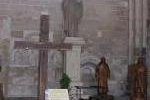
The most interesting aspect of the church of St Mary Magdalen was the collection of wooden crosses brought here in 1946 from all over Europe during a march for peace. One cross came from a group of POWs from Germany who had been held near here.
The village of Vezelay held a few other gems; the views over the villages of Asquins and St Pere-sous-Vezelay from the ramparts and the gateways of Barle and St Croix.
But best of all were the picturesque villages and the town of Avallon passed on the bus journey to Vezelay from Montbard station.
Keep reading 0 comments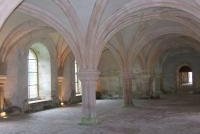
The restoration of this ensemble of buildings has been so carefully carried out that it is hard to believe that they are nearly 1000 years old. The grounds too are kept in pristine condition.
To reach this site I had no alternative but to take a taxi from Montbard station. In between showers of rain I moved from abbey church to cloiser to dormitories to kitchen and workshop, all of which lacked decoration and seemed most austere.
Keep reading 0 comments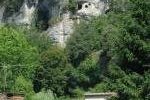
To visit this site I travelled by train to Les Eyzies de Tyack where I visited an informative Pre-history museum. But earlier in the day I had located the Font de Gaume, a series of caves high on a cliff. I managed to get on the first tour of the day when during an hour long tour the guide showed us spectacular paintings of many different animals, but mostly bison and reindeer.
I had wanted to reach the Lascaux caves, but there is an absence of transport in that part of the valley.
Keep reading 0 comments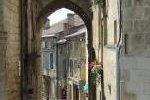
Reaching St Emilion is possible by bus or train from Libourne. I travelled by train to a station 2km south, downhill from the town. The road to the town was lined each side with huge vinyards. After passing through the Porte Bouqueyre it was easy to realise this was a special place. Besides all the caveaux for wine tasting there were several interesting buildings like the monolithic church, the Kings Tower and the Collegiate church.
I continued to the top end of the village where the buses stop. From here there were extensive views of the vinyards all around.
Keep reading 0 comments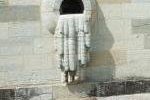
I reached Arc-et-Senans by train from Besancon and returned to Dole. Salines Les Bains can be accessed by bus from Mouchard station.
There is an interesting collection of models of buildings, built and unbuilt, by Ledoux in the tonnellerie.
Keep reading 0 comments
This site is best visited by train, as the railway runs through the site along the shore of Lake Geneva from Lutry to Vevey. It is a simple matter to get off at one of the small stations and walk through the vinyards to the next. At Lutry and Cully there are small trains that make tours through the vinyards and hamlets.
I was amazed at the amount of retaining work had been built to support the terraces, in the form of concrete walls, buttresses and rock anchors.
Keep reading 0 comments
As things are a bit spread out in Strasbourg I found a day ticket for the buses and trams invaluable at 3.60 euros. It enabled me to visit the Court of Human Rights, the European Parliament and the Council of Europe buildings in addition to Vauban's barrage and Petite France as well as the cathedal, churches and palaces on the Grand Ile.
Keep reading 0 comments